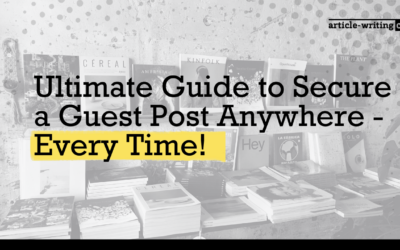Content marketing specialists have problems, too, you know? There are a lot of intricacies on your website or social media pages that only a marketer might notice, but as tiny as these details may seem to you, they may actually be of the many pet peeves of a content marketing specialist.
Do you optimize your photos to the right size? Do you send a pitch to LinkedIn contacts a nanosecond after they connect with you? Does your website have enough content published?
You may be innocent of these infractions, but it’s still likely you’re guilty of at least one the content crimes that get under a specialist’s skin. It might not seem like a big deal at first, but these hiccups may cost you customers and valuable partnerships. That’s okay, though. We’re here to highlight some these irritating little habits and show how you can avoid them.
Here are the top 10 pet peeves of a content marketing specialist:
1. Left on “Read”
Who said ghosting was only a thing in the dating world?
There’s almost nothing worse than shooting off an email only to have it totally ignored. Was it something you said? Maybe it was something you did. Is there another younger, prettier email campaign? Well, we don’t know about all of that. But, if your emails get left on read, there are definitely things you can do to improve your numbers.
HubSpot put together an educational list on some of the worst email marketing mistakes. Let’s take a quick look at this one:
Strike one: We’re pretty sure no one’s name is “*FNAME*” (no offence if it is). One of the best things you can do for your email marketing campaigns is to personalize your messages. Even if you automate your emails, do yourself a favour and send a test email to ensure everything looks okay.
A couple of other quick tips to better your email marketing are:
- Personalize your messages in other ways. It’s not just about getting someone’s name and company right. You can also send emails based on their behaviour, triggered by things like cart abandonment.
- Work on your subject lines. Your email marketing campaigns need a good hook. There’s no better way to get someone’s attention than with a subject line. Remember to keep things short and don’t stuff it full of jargon.
Congratulations, you’re officially equipped to avoid at least one of our top 10 pet peeves of a content marketing specialist. But, don’t go anywhere yet, the really important ones are just ahead.
2. Incorrect Photo Sizes
It’s relatively simple to upload photos to your site. If you’re not a stickler for size, uploading photos is a one-and-done kind of deal. But, when you publish photos to social media, you need them to be properly sized or your entire UX is shot.
You can easily correct these issues with useful tools like Pixlr, an online photo editing tool. To provide readers with an awesome experience, put in the time to crop photos accordingly.

3. Immediate Pitches
Companies love to send LinkedIn pitches before your cursor is even off the “Accept Connection” button. It’s nice to know they’re so eager, but it’s also obvious why they’re knocking on your door. Regardless of whether you’re on social media or chatting face-to-face, no one likes being talked at rather than spoken with.
You should strive for the same goal on LinkedIn as you do with your email marketing campaigns. Your main objectives should be to build relationships and increase trustworthiness. Sending immediate LinkedIn sales pitches isn’t going to earn you anything other than a rude response or a lack of credibility.
4. Green Eggs and Spam
“Wow, sweetie. Keep up the awesome content. We really learn a lot from you!” … said the obvious bot on your Instagram post. If it’s not those comments, it’s Twitter follows from people with a generic Google image for a profile photo. Whether you like it or not, spam is everywhere and it’s one of the biggest pet peeves of a content marketing specialist.
If you couldn’t tell from the photo, these guys follow back. At least they added over a dozen hashtags for good measure. These are the kinds of campaigns you see time and time again on social media. If you rolled your eyes as soon as you saw this photo, you’re probably not alone.
Even though you’re a real person, you can still commit acts of spam that bring an equal number of groans from customers. When you comment on someone’s post, guarantee that you’re providing value and personalized copy. Refrain from liking every photo under the sun, too. Go after your target audience in ways that initiate a conversation, not drive them further from your business.
5. #Overusing #Hashtags
Yikes. We get it. You really want that post of yours to rank. But that doesn’t mean #everything in your post needs its own hashtag. Just like the rest of the pet peeves of a content marketing specialist, the overuse of hashtags is unnecessary. Plus, it shows that you’re not targeting a specific audience. An abundance of hashtags may bring in some views, but if they’re not from the people you want, what’s the point?
Before you post anything on social media, you should do your research and create a plan. Who is your target audience? How do you plan to capture users’ attention with your content? Which hashtags truly yield the most results for your efforts?
Your content, no matter which platform you publish on, should serve to engage. Your captions should spark conversation with users and give them a reason to chat with you. It’s only then that prospective customers will be more enticed to visit your page.
Establishing a brand voice on social media (and in general) also bodes well. Take a look at Death Wish Coffee. On Instagram, the brand describes itself as “the world’s strongest coffee,” which gets to the point in one sentence.
However, they also use humour to engage with customers. A little logo in the corner with a funny quote is just enough to encourage comments and likes without being overkill. Plus, do you see a plethora of hashtags in their caption, because we don’t.
6. Lost Contact (Information)

Isn’t it great when you visit someone’s website and they have no way of getting in touch with them? Yeah, that’s the best. But, a better approach might be making your contact information obvious. Customers don’t want to visit your site and spend time hunting for information that should be right there on the homepage.
A contact page also serves as the perfect opportunity to show off your brand voice and incorporate some flair. Check out Urban Influence, a design firm with a killer contact page and website. (Which makes sense since, you know, they’re a design firm.)
Not only do they have an easy way to contact them on their page, but they also have their contact information at the bottom of their site. Everything is neatly laid out and they give you more than one opportunity to reach out to them without being pushy. And, as you can see from the example email, they sprinkled their personality throughout the page.
Spectoos published a great piece on how you can garner more leads with a contact page. With seven simple methods, you can attract new users and keep loyal customers satisfied.
7. Less Than Savoury Website
Your website needs to be top-notch. It’s not just about your customers, either. Your website should stand out from the competition and represent your business in a way that simple words can’t. Websites that are slow, have poor images, unfinished pages, or other glaring issues will turn off prospective clients.
There are a couple of easy things you can do to guarantee users a seamless experience on your website:
- Optimize your site for mobile devices. According to Statista, over half of worldwide website visits were done on mobile in 2018. Therefore, it should stand to reason that your website caters to portable devices and doesn’t slow down with the use of certain technology.
- Consider recruiting help. With the abundance of tools available today, building your own website isn’t impossible. That doesn’t mean you can do it better than the pros, though. If you really want to make heads turn, consider looking into hired help.
8. Didn’t I Just See That?
If you follow a company on their social media, it’ll become obvious when they share the same content on all platforms. Now, hang on one second. It’s more than fine to share a few relevant, valuable pieces across your channels. But, when all you share is the same content across your platforms, customers have no reason to follow you.
Much like how you should personalize your emails, you should do the same with your social content. Each platform comes equipped with its own set of algorithms, which is reason enough to cater to each one specifically.
9. Glamour-less Grammar
Do YOU enjoy readin’ content like this???? Sure, it’s acceptable to bend the rules of grammar a little in your content. A few exclamation marks here and some bolded words there grab a person’s attention without giving them a headache. But, when it’s every sentence and doesn’t add any value, customers will lose interest quickly.
Social media content suffers even more butchery, especially when it comes to character caps. This is where personalization comes in. As we mentioned, tweaking each message avoids grammatical errors, unpleasant reading experiences, and copycat content.
10. Irrelevant Content
A vital tool in your content marketing system is relevant, consistent articles. It’s not easy to build valuable, unique content for your audience, but it is possible. Research keywords, customer pain points, and competitors’ work to figure out where you want your content to go.
You can also create different kinds of engaging content. Visuals like videos, infographics, and original images can keep your customers’ attention and break up walls of text. Posts designed specifically for social media also add variety to your content.
Final Thoughts
These are just some of the top pet peeves of a content marketing specialist. We could almost bet that you share some of the same peeves! There is a light at the end of the tunnel, though. These easy steps will guide you in creating great content and side-stepping these obstacles.

David is the Founder and Director of article-writing.co, the fastest-growing content creation agency in North America. He has transformed companies by offering high-quality content that has impacted their SEO ranking, revitalized websites with engaging and industry-relevant blogs and website copy, and championed successful email campaign copy.




